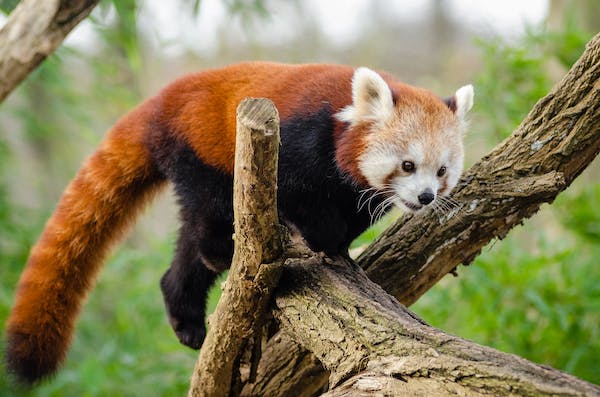Red panda : Taxonomy, Habitat, Diet, Behavior, conservation status.

Introduction:
Red pandas, often referred to as the “firefox,” are more than just cute faces. In this article, we’ll embark on a journey to understand these fascinating creatures better. From their habitat and behavior to conservation initiatives and cultural symbolism, join us in exploring the world of red pandas.
Taxonomy of the red panda (Ailurus fulgens) is as follows:
- Kingdom: Animalia
- Phylum: Chordata
- Subphylum: Vertebrata
- Class: Mammalia
- Order: Carnivora
- Family: Ailuridae
- Genus: Ailurus
- Species: Ailurus fulgens
Biome:
Red panda’s biome include:
Location:
The Eastern Himalayan broadleaf forests span across the eastern Himalayas, encompassing parts of Nepal, Bhutan, India, Myanmar, and southern China. Red pandas are specifically found in these temperate and subalpine forests.
Vegetation:
The biome is characterized by a variety of vegetation, including broadleaf deciduous and evergreen forests. Bamboo, a staple in the red panda’s diet, is a prominent feature of these forests. The diverse plant life contributes to the rich biodiversity of the region.
Climate:
The climate in the red panda’s biome is temperate, with distinct seasons. Winters are cold, and the red panda is adapted to snowy conditions. Summers bring a milder climate, creating a dynamic environment for these unique creatures.

Habitat and Behavior of Red Pandas:
Habitat:
Red pandas (Ailurus fulgens) are primarily found in the temperate broadleaf and mixed forests of the Eastern Himalayas. Their habitat spans a range of elevations, from 2,200 to 4,800 meters (7,200 to 15,700 feet) above sea level. These lush, mountainous terrains provide a diverse environment with a mix of broadleaf deciduous and evergreen trees.
Behavior:
Arboreal Lifestyle: Red pandas are skilled climbers, spending a significant portion of their lives in the trees.
Nocturnal Habits: Red pandas are primarily nocturnal, meaning they are more active during the night. This behavior helps them avoid predators and increases their chances of finding food, such as bamboo shoots and various fruits.
Communication Methods: Despite being solitary animals, red pandas use vocalizations for communication. These include whistles, chattering, and a distinctive twittering sound.
Foraging Techniques: Red pandas exhibit various foraging techniques, using their agile paws and specialized teeth to extract nutrients from bamboo, their primary food source. Their diet also includes fruits, berries, nuts, and even insects.
Seasonal Adaptations: Red pandas are adapted to cope with seasonal changes. Their thick fur provides insulation during cold winters.

Diet:
Despite their name, red pandas are not exclusively bamboo eaters. While bamboo constitutes a significant portion of their diet, they also enjoy fruits, berries, and occasional insects. This diverse diet ensures they obtain the necessary nutrients for their well-being.

Conservation status:
Vulnerable Status:
Red pandas are listed as vulnerable on the International Union for Conservation of Nature (IUCN) Red List. Their populations are declining due to habitat loss, poaching, and the impact of climate change on their bamboo-rich environments.

Interaction with Humans:
While red pandas charm visitors in zoos and conservation centers, their captivity comes with challenges. We’ll discuss the impact of human interaction on their natural habitats and the ethical considerations of keeping red pandas in captivity.
Red Panda Facts and Trivia
Thumb-Like Adaptation: Red pandas have a unique adaptation – an extended wrist bone that acts like a thumb. This “extra thumb” allows them to grasp objects with remarkable dexterity, particularly useful for handling their favorite foods.
Nocturnal Creatures: While they may look cuddly, red pandas are primarily nocturnal, meaning they are more active during the night. This behavior helps them avoid predators and maximize their chances of finding food.
Bushy Tails and Communication: The iconic bushy tail of red pandas serves multiple purposes. Apart from its use as a balance aid, red pandas also use their tails as a blanket to cover themselves during cold weather.
Socially Solitary: Red pandas are primarily solitary creatures, except during the breeding season. Adult red pandas usually prefer a solitary lifestyle, marking their territories with scent markings to communicate with potential mates.
Distinctive Markings: Each red panda has unique markings on its face, resembling a mask. This distinctive facial pattern aids researchers in identifying individuals in the wild, contributing to conservation efforts and population monitoring.
Short Gestation Period: Female red pandas have a relatively short gestation period of about 90 to 150 days. This brief reproductive cycle is a crucial adaptation to their challenging environment.
Cautious Drinkers: When red pandas drink water, they use their paws to scoop it up before bringing it to their mouths. This cautious drinking behavior might be an instinctual response to avoid contaminants in the water.
Photos of Red Panda:






One thought on “Red panda : Taxonomy, Habitat, Diet, Behavior, conservation status.”